Lord Parker on Abnormal and Indivisible Loads
Page 29

If you've noticed an error in this article please click here to report it so we can fix it.
LORD PARKER, the Lord Chief Justice, said in the Queen's Bench Divisional La Court last week that he thought the meaning of '" abnormal and indivisible load "—bringing a vehicle outside the nonnal maximum-load regulations—was:
Some large piece of machinery, such as a boiler, which cannot in any ordinary sense be divided into two smaller loads without the expense of pulling the machinery to bits or considerable risk of damage to it."
Mr. Justice Salmon said: I think this regulation about abnormal and indivisible loads applies only to a load which is in a true sense one entity, like a boiler or a piece of machinery which it would be extremely difficult and expensive to dismantle."
Their lordships, with whom sat Mr. Justice Winn, dismissed, with costs, the appeal of Siddle C. Cook, Ltd., of Consett, Co. Durham, and their driver, William Thompson, against a conviction by Alnwick, Northumberland, magistrates on January 6, 1960, of using an articulated lorry on the Great North Road with a load weighing more than the 24 tons permitted by the Motor Vehicles (Construction and Use) Regulations, 1955.
There was no doubt, said Lord Parker, that this was a vehicle designed for "abnormal and indivisible loads," but was it carrying such a load on the date in question? The load was 10 steel boxpiles, 70-ft. long, with a total weight of 36 tons 11 cwts.
"There were really 10 articles
embodied in the load. To bring it within the regulations it was merely a question of loading five on one vehicle and five on another,"
The justices, he said, had found correctly that this could have been done
without "undue expense" -the additional cost would be no more substantially than the loading and unloading and that of running a second vehicle.
The court decided the case on the divisibility point alone and made no finding on the argument that in any case this vehicle would not be within the protection of Regulation 14, of the Motor Vehicles (General Types) Order, 1955. because it was not operating subject to the conditions and restrictions as to speed and notification to the police. The court preferred to leave that point open.
















































































































